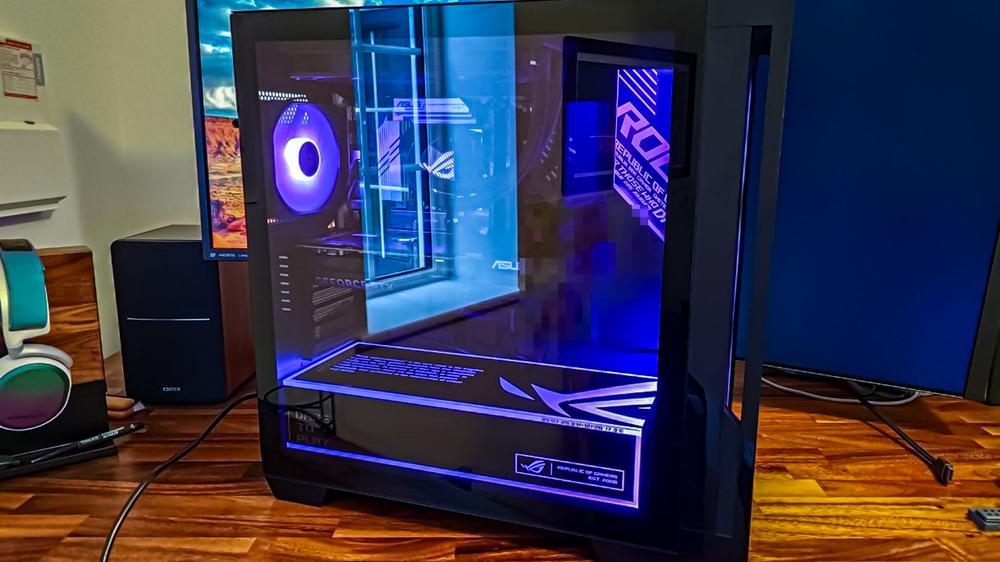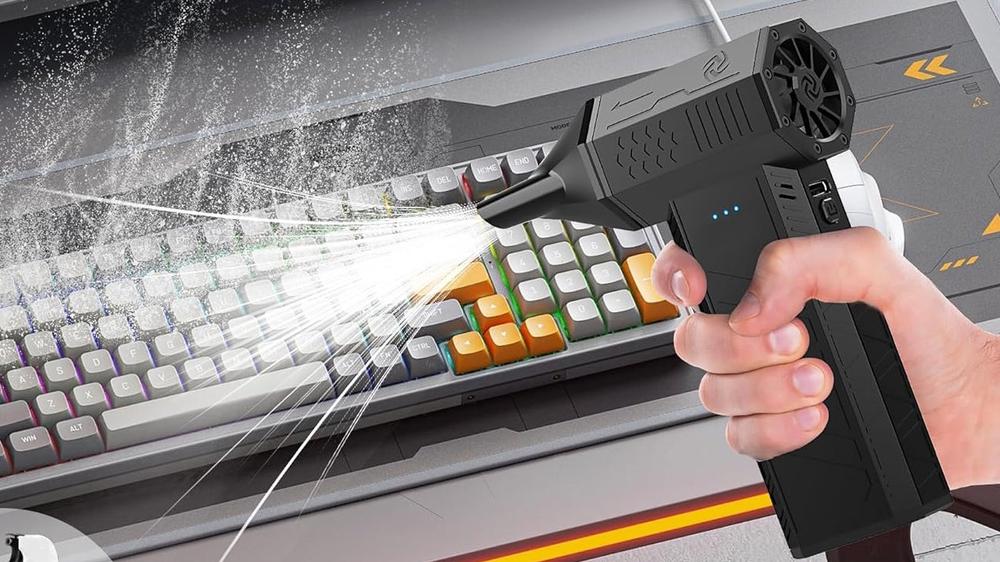When it comes to buying a new gaming PC, one of the main reasons to buy an off-the-shelf option rather than building one yourself is to get something reliable that is professionally put together. As good as my cable management skills are, they rarely measure up to what the pros can manage.
I want a good spread of hardware to choose from, though, which is why it’s encouraging to see such a broad swathe of configurations from the Asus ROG G700. If you want something modest and affordable, there are options for that. If you’d rather kit it out with the fastest CPU and GPU combination money can buy, that option’s there too. In any case, you get the same high build quality, sleek-looking, gaming PC with a roomy case, capable cooling, and attractive RGB lighting.
It’s a big’ old system, though. So you’ll want to ensure you have plenty of space on your desk or floor, and that you’re feeling strong on the day it arrives – or at least get someone to help you.
Design and Features
The G700 is a full-tower gaming PC measuring 18.88 inches tall and 20.05 inches long, and that doesn’t include the feet, which give it at least another inch of verticality. That means this system takes up a lot of space wherever you put it, but conversely also has plenty of internal volume which makes future maintenance or upgrades much easier.
In the more immediate term, however, it means you can enjoy a lot of the ROG branding that Asus covered this PC with. That’s going to be a love it or hate it thing for most folks, and it’s worth considering this PC is for gamers. That perhaps shouldn’t surprise considering it’s part of the ROG family, which of course stands for Republic of Gamers. This is no sleeper system, with RGB-lit ROG branding along the PSU shroud and on an acrylic panel just behind the front fans.
There’s even a multi-sentence mission statement of sorts on the PSU shroud which talks about how ROG kingdom gamers don’t conform and stand out from the pack. An interesting juxtaposition for a mass-produced gaming PC.
Cable management is excellent, with Asus seemingly adopting a design philosophy of hiding wires where it can, and making them flow with the natural lines of the system where it can’t. There’s a shroud for the 20+4 pin power connector, a PSU shroud that covers the entire base of the case, and the PWM fan cables and 12v-2x6 connector are as tucked away as they can be, giving everything a clean aesthetic.
It’s decidedly forward-looking in its design, lacking any kind of 2.5-inch and 3.5-inch drive bay space. There’s enough physical room for heaps of drives, but no mounting solutions. That makes bringing over older SATA drives from your previous PC a little tricky. You can wedge them in behind the PSU shroud with some double-sided tape, but there are no mounting holes for them.
It actually feels like Asus missed a trick there. It could easily have included some screw holes on the back of the motherboard tray for some 2.5-inch drives and there’s a clear spot at the front where a 3.5-inch drive could be fitted to the floor.
If you don’t care about such ancient standards, and most of the people buying this system off-the-shelf probably don’t, it’s no big deal, but it’s something worth bearing in mind if you’re upgrading and want to bring some of your storage with you.
Still, this is one system you’re going to want to dust regularly to keep that sleek and clear aesthetic alive. You won’t need to worry about GPU sag though, as Asus has installed a sturdy GPU bracket that fits the aesthetic without standing out.
Front panel connectors include a pair of USB-A 3.2 gen 1 and a single USB-C 3.2 gen 1, as well as mic and headphone inputs – plenty for most uses. Since this system uses a B860 motherboard, the back isn’t extensive, though you still get nine USB-A ports topping out at 3.2 Gen 2, and a USB-C 3.2 gen 2 port, as well as Gigabit ethernet, DisplayPort 1.4 for onboard graphics, and a trio of audio connectors. The 5070 Ti in this build has the standard three DisplayPorts and a single HDMI connector.
It has all the ports you need for standard peripherals like keyboards and mice, though if you’re the kind of person who does a lot of big data transfers to external drives you might want to invest in some faster ports via a PCIe card.
The PSUs is LiteON branded which is a well known OEM of strong-enough repute that I’m not concerned about it powering the components. At 850W and 80+ Gold rated, it’s got enough going for it that you shouldn’t need to upgrade any time soon. There’s nothing in the way of spare cables, though, so you’ll need adapters if you want to add any add-in cards that require external power.
Performance
AMD might get the most love for its gaming CPUs this generation, but the Intel’s Core Ultra 265K and combined with the 5070 Ti, this PC is more than capable of hitting high frame rates and punching above its weight. I wouldn’t typically consider the 5070 Ti a 4K graphics card, but in most of the games in our test suite, the ROG G700 delivered excellent performance.
It managed over 100 fps in many of the games we tested at 4K, including Forza Horizon 5, Black Ops 6, and Metro Exodus: Enhanced Edition – and that’s without frame generation, too. Even the more demanding games, like Cyberpunk and Black Myth Wukong were very playable considering their settings were almost completely maxed out, though DLSS certainly helped smooth out the FPS.
With frame generation enabled we saw much higher frame rates in those two super-demanding games, though with a bit of noticeable flicker in Black Myth Wukong, which would encourage me to play without it – but your mileage may vary. It’s much more of a useful option in Forza, though, where it took the fps very close to a buttery smooth 190 FPS.
3DMark Speedway77063DMark Port Royal188433DMark Steel Nomad 6878Total War Warhammer III (Ultra, 4K)89Forza Horizon 5 (Extreme, 4K, DLSS Performance)149Forza Horizon 5 (Extreme, 4K, DLSS Performance, Frame Gen)188Call of Duty: Black Ops 6 (Extreme, 4K, DLSS Performance)116Cyberpunk 2077 (Ray Tracing Ultra, 4K, DLSS Performance)77Cyberpunk 2077 (Ray Tracing Ultra, 4K, DLSS Performance, Frame Gen 2x)122Cyberpunk 2077 (Ray Tracing Ultra, 4K, DLSS Performance, Frame Gen 4x)210Metro Exodus: Enhanced Edition (Extreme, 4K, No upscaling)105Black Myth Wukong (Cinematic, 4K, DLSS Performance)46Black Myth Wukong (Cinematic, 4K, DLSS Performance, Frame Gen)75Total War: Warhammer III is a great test, as it’s a demanding, but older, DirectX 11 game that doesn’t offer any kind of dynamic upscaling or frame generation support; It’s all pure, raw rasterized rendering. The ROG G700 performed admirably there, almost hitting 90 FPS which looks great on a high refresh rate display.
Unfortunately, when you start gaming quite hard the fans spin up enough that noise levels do become quite noticeable. You’ll probably want to game in headphones for more demanding games that push the heat and fan speed up.
The standard configuration is strong, though, with Asus holding back from filling the system with bloatware. Resizeable BAR is enabled by default too, which is nice to see, although oddly XMP wasn’t. That’s an easy fix, but seems like an odd oversight when so much thought and care seems to have gone into the rest of the system.
Then, during general office work, web browsing, and streaming, the Asus ROG G700 isit’s quiet and lacks any kind of obvious coil whine. Performance is strong, with everyday tasks feeling snappy and responsive

 Get a Cordless Electric Air Duster for PC Cleaning for Just $18, the Best Price So Far for Black Friday
Get a Cordless Electric Air Duster for PC Cleaning for Just $18, the Best Price So Far for Black Friday